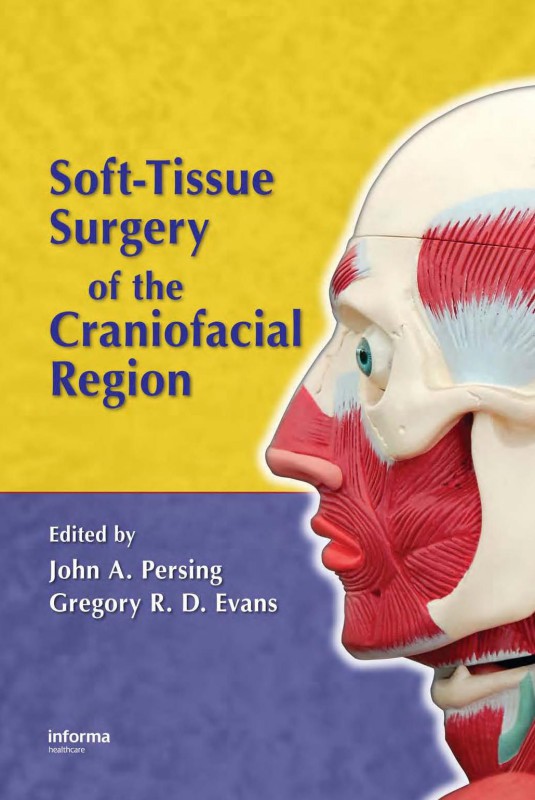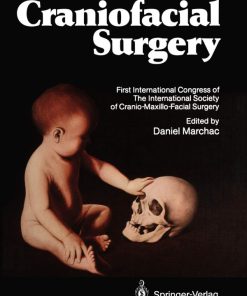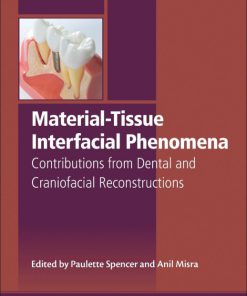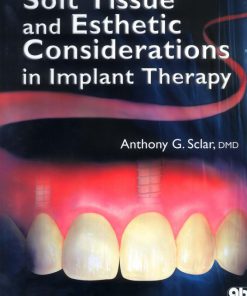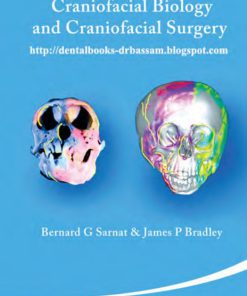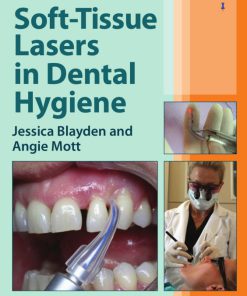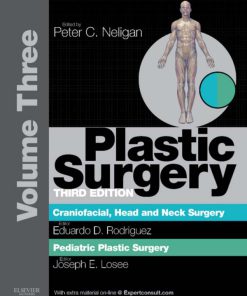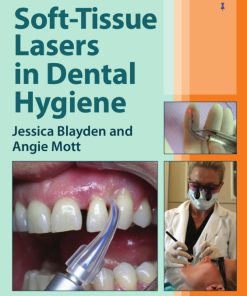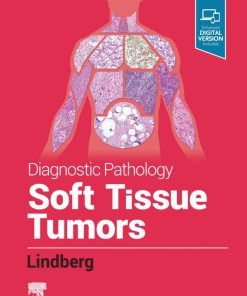Soft Tissue Surgery of the Craniofacial Region 1st Edition by John Persing, Gregory Evans ISBN 9781040163474 1040163475
$50.00 Original price was: $50.00.$25.00Current price is: $25.00.
Authors:Informa Healthcare; 1 edition (June 20, 2007) , Author sort:edition, Informa Healthcare; 1 , Published:Published:May 2007
Soft Tissue Surgery of the Craniofacial Region 1st Edition by John Persing, Gregory Evans – Ebook PDF Instant Download/Delivery. 9781040163474 ,1040163475
Full download Soft Tissue Surgery of the Craniofacial Region 1st Edition after payment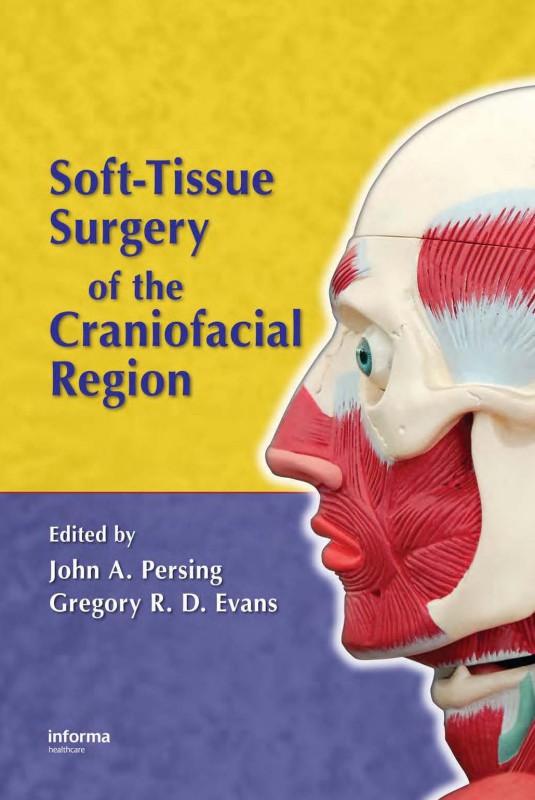
Product details:
ISBN 10: 1040163475
ISBN 13: 9781040163474
Author: John Persing, Gregory Evans
Soft Tissue Surgery of the Craniofacial Region 1st Edition Table of contents:
1. Introduction to Various Lasers
Basic Principles and Therapeutic Uses (Including Side Effects)
Q-Switched Ruby Lasers
Q-Switched Alexandrite Lasers
Q-Switched Neodymium:Yttrium-Aluminum-Garnet Lasers
Pulsed Dye Lasers
Argon-Pumped Tunable Dye Lasers
Copper Vapor Lasers
KTP Lasers
Krypton Lasers
Carbon Dioxide Lasers
Erbium:Yttrium-Aluminum-Garnet Lasers
Argon Lasers
2. Medial and Lateral Canthal Reconstruction
Background
Anatomy of the Lateral and Medial Canthi
Reconstructive Techniques For the Lateral Canthus
Dermal Orbicular Pennant
Indications
Technique
Strengths
Weaknesses
Inferior Retinacular Lateral Canthoplasty
Indications
Technique
Strengths
Weaknesses
Transpalpebral Lateral Retinacular Suspension
Indications
Technique
Strengths
Weaknesses
Lateral Tarsal Strip
Indications
Technique
Strengths
Weaknesses
Lateral Canthopexy
Indications
Technique
Strengths
Weaknesses
Reconstructive Techniques For the Medial Canthus
Healing By Secondary Intention
Indications
Technique
Strengths
Weaknesses
Full-Thickness Skin Grafts
Indications
Technique
Strengths
Weaknesses
Local Tissue Flaps
Indications
Techniques
V-Y Advancement Flap
Glabellar Flap
Mustarde Flap
Strengths
Weaknesses
Myocutaneous Flaps
Indications
Technique
Strengths
Weaknesses
Medial Canthopexy
Indications
Technique
Medial Canthopexy For Nontraumatic Injuries
Medial Canthopexy For Traumatic Injuries
Strengths
Weaknesses
Medial Tarsal Strip
Indications
Technique
Strengths
Weaknesses
Conclusions
References
3. Eyelid Reconstruction
Introduction
Patient Evaluation
Ocular Surface Disease
Anatomy
Anesthesia
Blepharoplasty
Cosmetic Vs. Functional
Upper Blepharoplasty Technique
Lower Blepharoplasty Technique
Complications
Blepharoptosis
Evaluation
Aponeurotic Vs. Neuromuscular Blepharoptosis
Aponeurotic Blepharoptosis
Neurogenic Blepharoptosis
Myogenic Blepharoptosis
Blepharoptosis Management
External Levator Aponeurosis Advancement Technique
Complications
Ectropion
Involutional Entropion
Tarsal Strip Technique
Cicatricial Entropion
Paralytic Ectropion
Mechanical Ectropion
Entropion
Involutional Entropion
Transcutaneous Lower-Eyelid Retractor Repair
Acute Spastic Entropion
Cicatricial Entropion
Eyelid Retraction
Upper Eyelid Retraction
Lower Eyelid Retraction
Eyelid Reconstruction
Lacrimal Drainage System
Medial Canthal Reconstruction
Anterior Lamellar Reconstruction
Full-Thickness Eyelid Reconstruction
References
4. Lip Reconstruction
Introduction
History
Anatomy
Innervation of the Lips
Vascular Supply
Conditions Requiring Reconstruction
Lip Reconstruction
Post-Traumatic Lip Reconstruction
Lip Anesthesia and Block Techniques
Vermilion
Mucosal Reconstruction
Lower Lip Reconstruction
Nasolabial
Abbe Flap
Estlander Flap
Karapandzic Flap
Gillies Fan Flap
Webster Cheek Advancement Flap (Modified Bernard-Burow)
Upper Lip Reconstruction
Perialar Crescentic Advancement Flap
Distant Flaps
Visor Flap
Free Tissue Transfer
Lip Augmentation
References
5. Scar Revision, Dermabrasion, Local Flaps
Introduction
Scar
Normal Wound Healing and Scar Formation
Abnormal Wound Healing
Noninvasive Measures
Minimally Invasive Measures
Bovine Collagen
Autologous Collagen
Allogeneic Collagen
Autologous Fat Injection
Restylane/Perlane
Radiance
Artecoll®
Dermabrasion
Surgical Approach
Excision
Z-Plasty
W-Plasty
Broken-Line Closure
Local Flaps
Advancement Flaps
Rotational Flaps
Transposition Flaps
Postoperative Care
Complications
Summary
References
6. Microsurgical Reconstruction of Craniofacial Soft-Tissue Defects
Introduction
Facial Hemiatrophy (Parry-Romberg Syndrome)
Maxilla
Mandible
Frey’s Syndrome
Mastoidectomies
Recipient Vessels
References
7. Hair Transplantation
Associated Patterns and Types of Baldness
Patient Evaluation
Anesthesia
Surgical Technique
Conclusion
References
8. Forehead/Brow/Soft-Tissue Surgery for Migraines
Introduction
Clinical Presentation of Migraine Headaches/Diagnosis
Surgical Background and Significance
Etiology and Pathophysiology
Patient Selection
Constellation of Symptoms to Aid in Identification of Trigger Sites
The Algorithm For Identification of the Trigger Sites
Surgical Procedures
Frontal Trigger Site
Temporal Trigger Site
Occipital Trigger Site
Intranasal Trigger Site
Inferior Turbinectomy
Middle Turbinectomy
Summary
References
9. Management of Velopharyngeal Dysfunction
The Problem: Velopharyngeal Dysfunction
Role of the Speech Pathologist
The Relationship Between Speech Pathologist and Surgeon
Anatomy
Basic Speech Terminology For the Surgeon
History and Physical Examination: Focus of the Initial Consultation
Questions
Findings
Provocative Tests
Airway Evaluation
Instrumental Assessment of Speech
Managing Vpd
Nonsurgical and Treatment Options
Contraindications To Surgery
What About Aberrant Carotid Arteries?
Surgical Procedures For Vpd
Candidates For Pharyngeal Flap
Different Kinds of Pharyngeal Flaps
What is the Appropriate Level and Width of Pharyngeal Flap?
Lining the Pharyngeal Flap
Level of Flap Inset Affects Outcome
Can Lateral Port Size Be Controlled?
Can Specifications of the Pharyngeal Flap Be Tailored to Patient’s Needs?
Basing the Flap Superiorly Or Inferiorly
Sphincter Pharyngoplasty
Candidates for Sphincter Pharyngoplasty
Operative Technique
Long-Term Outcome of Sphincter Pharyngoplasty
Postoperative Care
Complications
Axioms
Complex Problems Associated With Vpd Research
Future Diagnostic/Assessment/Treatment Modalities
References
10. The Lacrimal Outflow System
Anatomy
History
The Lacrimal Canalicular System
Trauma
Clinical Findings
Treatment
Canalicular Obstruction
Treatment
Silicone Intubation
Conjunctivorhinostomy (Jones Tube)
Canaliculitis
Clinical Findings
Epidemiology
Pathology
Microbiology
Treatment
Lacrimal Sac and Nqasolacrimal Duct Dacryocystitis
Clinical Presentation
Acute Dacryocystitis
Chronic Dacryocystitis
Epidemiology
Predisposing Factors
Radiological Evaluation
Causes of Obstruction
Chronic Inflammation
Congenital Variations
Associated Nasal Or Sinus Disease
Extrinsic Neoplasia
Tumors of the Lacrimal Sac
Trauma
Types of Injuries
Failures in Management
Summary
Systemic Disease
Dacryoliths
Microbiology of Dacryocystitis
Complications
Treatment
Incision and Drainage
Nasolacrimal Duct Dilatation
Dacryocystorhinostomy
Endoscopic DCR
External DCR
The Simplified External DCR
Dacryocystectomy
Neonatal Dacryocystitis
Epidemiology
Microbiology
Treatment
References
11. Facial Burns: Management and Reconstruction
Introduction
Initial Management of Burns Involving the Face
Facial Burn Wound Management
Adjunctive Nonoperative Techniques
Reconstruction After Facial Burns
Reconstructive Ladder After Burn Scar Excision
Reconstruction of Specific Structures
Scalp
Forehead
Eyebrow
Eyes and Eyelids
Nose
Cheek
Perioral Area
Neck
Ear
Psychological Issues
Conclusion
References
12. Cheek Reconstruction
Introduction
Contour Defects
Cervicofacial Flap
Laterally Based Cervicofacial Flap
Anatomy and Blood Supply
Medially Based Cervicofacial Flap
Technique
Round Block “Purse-String” Suture Method
Technique
Complications
Conclusion
References
13. Traumatic Tattoo
Introduction
Mechanism
Pathophysiology
Treatment Options
Surgical
Mechanical
Chemical
Photothermic
Management
Acute
Chronic
Conclusion
References
14. Composite Reconstruction of Midface Defects
Introduction
General Principles
Local Flaps for Cheek Reconstruction
Cheek Rotation Advancement Flap
Submental Artery Flap
Free Tissue Transfer
Maxillectomy Defect Reconstruction
Soft-Tissue Cheek Reconstruction
Scapular and Parascapular Flaps
Anterolateral Thigh Flap
Other Flaps
Donor Vessels in Cheek Reconstruction
Facial Nerve
Summary
References
15. Blepharoplasty
Introduction
Etiology
Pertinent Anatomy—Normal and Pathologic
Surgical Considerations
General
Persing and Knoll Surgical Technique
Anesthesia
Markings
Upper Eyelids
Lower Lid
Postoperative Care
Complications
Secondary Blepharoplasty
References
16. Cheek Reconstruction: Regional and Microvascular Free-Tissue Transfer
Introduction
Anatomy
Evaluation
Treatment
Local Flaps
Rhomboid Flaps
V-Y Flaps
Skin Grafts
Tissue Expansion
Cervicofacial Flap
Submental Flap
Pectoralis Flap
Trapezius Flap
Supraclavicular Flap
Free-Tissue Transfers
Flap Prefabrication and Prelamination
Complications
Flap Necrosis
Ectropion
Disruption of Hairline
Conclusion
References
17. Facial Fractures
Introduction
Physical Examination and Soft-Tissue Considerations
Neurologic
Scalp
Skin
Eye
Ear
Nose
Throat
Neck
Radiologic Workup of Mandible Fractures
Periapical View
Plain Films
Panoramic Radiography
Occlusal View
Computed Tomography
Radiologic Workup of Midface Fractures
Treatment of Mandible Fractures
Principles of Mandibular Fixation
Orbital Zygomatic Fractures: Orbital and Zygomatico-Maxillary- Complex Fractures
Orbit and Zmc: A Combined Problem and Topic
Initial Physical Examination and Management
Radiographic Assessment
Surgical Approach to the Orbit
Correction of Orbital Anatomy and Orbital Volume
Reduction of the Zygoma
Nasal and Nasal Orbital Ethmoid Fractures
Le Fort and Palatal Fractures
Frontal Sinus Fractures
Staging of Panfacial Fractures
References
18. Rhinoplasty
Introduction
Anatomy
Skin
Muscle
Blood Supply
Nasal Vaults
Nasal Function
Preoperative Assessment
The Initial Consultation
Nasofacial Analysis
Operative Technique
Type of Approach
Anesthesia/Preoperative Preparation
Incision—Closed Approach
Incision—Open Approach
Skin Envelope Dissection
Nasal Dorsum
Septal Reconstruction/Cartilage Graft Harvest
Inferior Turbinoplasty
Cephalic Trim
Spreader Grafts
Tip Modification
Altering Tip Projection
Altering Tip Rotation
Osteotomies
Closure
Postoperative Management
Secondary Rhinoplasty
References
19. Imaging of Soft-Tissue Defects
Introduction
Physical Domain
Informational Domain
Cognitive Domain
Tissue Modeling—Two-Dimensional and Three-Dimensional
Simulation
Simulation of Surgical Procedures
Simulation of Tissues
Background Research in Tissue Simulation
Early Applications to Surgical Training
Tissue Simulation in Plastic Surgery
Computer-Aided Plastic Surgery: Pre-Op Planning
Datafusion: Perioperative
Discussions and Future Predictions
References
20. Managing the Cleft Nasal Deformity: Controversies in Correction
Introduction
Unilateral Cleft Nasal Deformity
Nasoalveolar Molding
Primary Unilateral Cleft Nasal Repair
Secondary Repair of the Unilateral Cleft Nasal Deformity
Outcomes
Bilateral Cleft Nasal Deformity
Primary Bilateral Cleft Nasal Repair
Secondary Bilateral Cleft Nasal Repair
Outcomes
Conclusion
Summary
References
21. Skin Care (Peels, etc.)
Benefits of Incorporating An On-Site Skin Care Clinic
Skin Care Consultation
Pretreatment
Treatments
Skin Care Products
Sunscreens
Tretinoin
Alpha-Hydroxy Acids
Topical Growth Factors
Topical Vitamin C
Formulation for Hyperpigmentation
Conclusion
References
22. The Subperiosteal Facelift
Introduction
The Anatomic Basis for the Subperiosteal Facelift
Indications for the Subperiosteal Facelift
Methods of Soft-Tissue Suspension
The Open Subperiosteal Facelift
The Endoscopic Subperiosteal Facelift
Surgical Technique
Endoforehead Procedure
Endomidface Procedure
Bichat’s Fat Pad Excision
Fat Grafting
Postoperative Care
Complications
Summary
References
23. Cleft Palate
Introduction
Epidemiology
Anatomy
Embryology
Timing of Surgery
Surgical Methods
Von Langenbeck Palatoplasty
Bardach Two-Flap Palatoplasty
V-Y Pushback/Three-Flap Palatoplasty
Double Opposing Z-Plasty Palatoplasty
Postoperative Care
Complications
Summary
References
24. Aplasia Cutis Congenita
Introduction
Etiology
Epidemiology
Clinical Findings
Pathology
Differential Diagnosis
Complications
Treatment
Prevention
References
25. Mentoplasty
Introduction
Clinical Anatomy
Patient Assessment
Aesthetic Chin Concepts
Alloplastic Materials
Indications, Advantages, and Disadvantages
Materials
Surgical Technique
Complications
Bony Procedures
Indications, Advantages, and Disadvantages
Surgical Technique (Osteotomies)
Complications
Surgical Technique (Osteotomies)
Complications
Summary
References
26. Facial Paralysis
Introduction
Anatomy
Facial Nerves
Facial Muscles
Functional and Aesthetic Problems in Facial Paralysis: Patient Evaluation
“Urgent” Priorities: Corneal Protection
“Not-So-Urgent” Priorities: Examination and Diagnosis
Management
If the Ipsilateral Facial Nerve is Available and the Facial Muscles Are Available
Etiology
Treatment: Nerve Repair and Grafting
Single Branch (Partial) Paralysis
If the Ipsilateral Facial Nerve is Not Available and the Facial Muscles Are Available
Etiology
Treatment
Hypoglossal Nerve and the “Babysitter” Principle
Cross-Facial Nerve Grafting
If Facial Muscles Are Not Available
Etiology
Upper Face and Brow Region
Eyelids
Lower Face
Results
Pediatric Facial Paralysis: Special Considerations
Adjunctive Procedures
Botulinum Toxin
Lower Lip Procedures
Procedures to Manage Facial Aging in Facial Paralysis
Summary
References
Index
People also search for Soft Tissue Surgery of the Craniofacial Region 1st Edition:
soft tissue triangle rhinoplasty
a soft tissue in the center of some bones
nose soft tissue triangle
a specialized technique of soft-tissue manipulation is called
You may also like…
eBook PDF
Soft Tissue Lasers in Dental Hygiene 1st Edition by Jessica Blayden 9781119025054 1119025052

